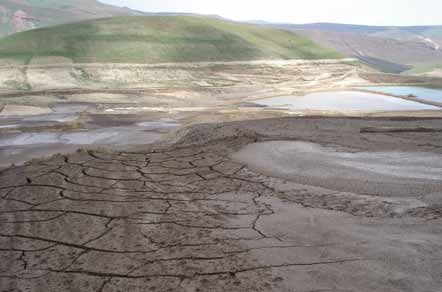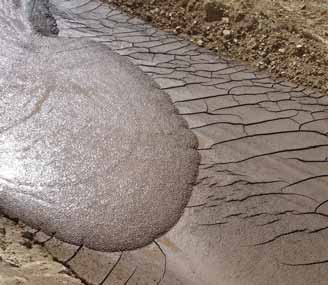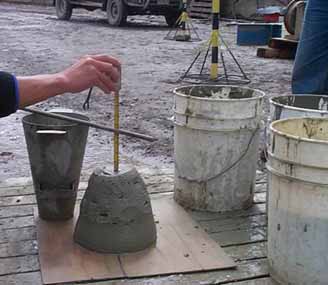
A paste deposit, as shown here, is one alternative among many in a range of possible
thickened tailings formulations. The right choice for any specific tailings application
depends on a variety of of factors.
Thickened Tailings Offer Effective Disposal Alternatives
As standard industry methods for tailings disposal receive mounting economic and
social scrutiny, paste may become an increasingly attractive option
By Frank Palkovits

The result of the combination of these pressures is that mining company executives feel like the toothpaste in a tube that is being squeezed by several people at once. And as it happens, one possible solution involves a substance that can have the consistency of toothpaste. This substance is “paste,” a homogeneous non-segregating material defined as tailings with minimal water content that typically sufficient water to allow pumping and pipeline transport. Paste travels as a plug flow and exits the pipe looking and flowing much like toothpaste.
However, paste is only one subset of a
larger range of formulations of “thickened
tailings,” and the right form for each situation
depends on a variety of factors, as
we’ll see. For hard rock tailings, the typical
slurry densities are:
• Conventional slurry is the most dilute
form, typically 30% to 50% solids, and
can be moved with a centrifugal pump.
Given a water-constrained world, slurry
may see less application in future.
• Thickened non-segregating slurry is typically
60% to 65% solids, and can also
be moved with a centrifugal pump.
• Filtered tailings, generally over 80%
solids, is too thick to pump, and must be
moved on a conveyor belt or by truck.
Choosing Between Thickened
Tailings and the Alternatives
As with any technology, there are situations
in which thickened tailings may be the
best solution, and those where other methods
may be best.
There is the financial cost of the equipment to be considered, and this cost must be borne before production begins and revenue flows. However, the capital cost is often less than that for the dam needed for conventional slurry deposition. The operating cost may be higher than it is for conventional deposition, partly because of the more complex machinery involved.
There also may be some difficulty predicting the stability of the thickened tailings beaches at the design stage.
Experience has shown that some ores, such as kimberlites, tend to not “thicken” well, have large variability in material characteristics and can flash-set when mixed with cementituous products in backfill.
Technical solutions for these issues will likely develop sooner rather than later, given the need to deal with issues such as those listed at the start of this article.
Another factor is that not all mines have tailings suitable for thickened applications. Some of this is because a major factor in the behavior of the thickened tailings is the grain size. Mine managers will generally choose a grain size that maximizes recovery, and this is not necessarily the optimal size for thickening purposes. However, as mining companies become increasingly concerned with closure and ongoing costs, this picture may change.
One of the most important benefits to tailings thickening is that it can reduce or eliminate the risk posed by ponded water on top of conventional tailings sites. This significantly reduces ongoing post-closure costs and liabilities. While thickened tailings cannot for the foreseeable future promise complete “walk-away closure,” it is a big step toward that elusive but desirable goal.
Transporting tailings in paste form to the disposal site uses less water than does slurry, so that water-management issues are much reduced. In drier parts of the world we see increasing pressures to reduce water use, and these concerns are also appearing in areas with more plentiful rainfall.
Because there is no particle segregation with thickened tailings, the tailings mass is denser, requiring less geographic area that must be permitted. The density also allows better control of wind and water erosion, further reducing environmental risks.
In many cases thickened tailings can be stacked, again reducing the surface area needed. In situations where disposal space is limited, having a practical tailings- disposal option may mean the difference between being able to mine a promising ore body, or not.
Thickened tailings deposits can support loads more quickly than can other forms of disposal, so that they can be mechanically vegetated. This facilitates progressive closure—one part of the facility can be growing vegetation while another is being filled. This helps tie closure costs more closely to the revenue associated with those tailings. It also has a positive publicrelations aspect in that the company can point to the grasses, shrubs and trees on the tailings site as evidence of its good corporate behavior.
Choice of Disposal Options
Depends on Circumstances
There is a wide range of disposal options
for thickened tailings, and the right
choice depends on mineralogy, the
degree of weathering of the parent ore,
mineral extraction process, the degree of
grinding, the reagents used in the
milling process, acid generating potential,
the specific gravity of the tailings
particles and other factors.
Surface disposal
While some surface disposal of thickened
tailings involves a significant containment
berm, one advantage of paste is that a
major containment structure may be
unnecessary. These higher-density formulations
of thickened tailings have only minor
propensity to bleed water, so that just a
small berm around the deposit is needed to
catch the bleed and precipitation runoff.
Disposal in mined-out open pits
While disposing of tailings in an existing
open pit has great advantages in that it
does not require additional area to be permitted, it has its challenges. The first
is
that companies are naturally reluctant to
deposit tailings in a pit until they are sure
they have extracted all of the economic
ore—and the definition of “economic” is
partly a function of the commodity price.
Also, an open- pit is sometimes just the
start of a mining process that continues
underground.
The viability of open-pit disposal depends partly on the groundwater regime and the permeability of the surrounding rock. It has been a solution with uranium tailings in Saskatchewan, Canada with special measures taken to understand the hydro-geology and seepage issues.
Cyclone sand dam
Tailings ponds can be smaller if there is
less mine waste that must be covered with
water. A cyclone station can separate the
tailings. The cyclone’s overflow of fines,
requiring sub-water deposition, are placed
upstream from the containment dam,
while the unsaturated free-draining sand
underflow is placed downstream of the
dam. Typically 65% solids, the cyclone
sand underflow can be moved to its storage
site by a positive displacement pump.
Underground disposal
Underground deposition of tailings can
reduce the amount of surface area
required. However, surface disposal cannot
be eliminated. At best, about 60% of the
tailings can be placed underground, in part
because the density of the tailings is about
half that of the ore removed. As well as
reducing the surface-disposal footprint,
underground disposal of cemented tailings
can provide ground support to minimize or
prevent subsidence or collapses to surface.
This is becoming increasingly important as
a way to limit post-closure liabilities.


In an open-pit operation, it may be possible and practical to fit all of the tailings into the voids in the rock—rendering a traditional tailings pond unnecessary. Studies indicate that this may not be as possible for underground mining, largely because there is less availability of waste rock. Some additional storage for tailings may be necessary, possibly as a layer of paste rock as as cover for the paste deposit.
Paste rock, as with other aspects of thickened tailings, involves tried-and-true technologies but is also an area of rapid technological growth. These developments hold significant promise for the mining sector in its drive to manage its environmental and social impacts.
Frank Palkovits, P.Eng. (fpalkovits@golder.com) is senior project engineer with Golder Paste Technology, based in Sudbury, Canada.